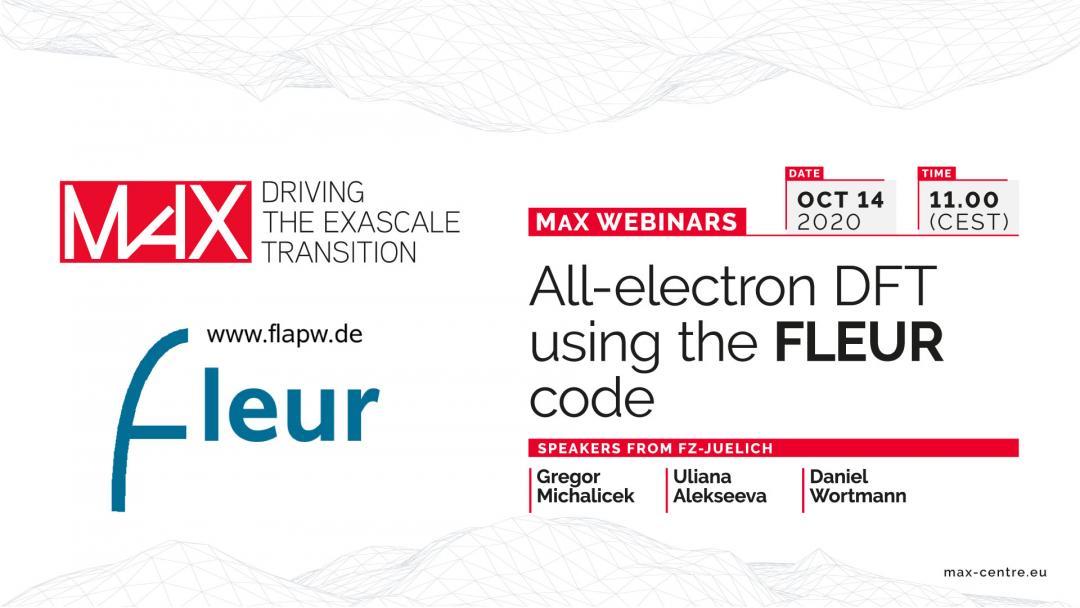
Thank you for joining MaX webinar on "All-electron DFT using the FLEUR code".
The webinar slides and video recording are available below.
Download a copy now!
- Introduction to FLEUR and FLAPW - Gregor Michalicek (Forschungszentrum Jülich)
- Pushing FLEUR to the limits: Large magnetic setups - Uliana Alekseeva (Forschungszentrum Jülich)
- Getting FLEUR to run on your machine, Future of FLEUR - Daniel Wortmann (Forschungszentrum Jülich)
- Q&A Session
See you on our next webinar for BigDFT on 12 November. Stay tuned for the next announcement.
Description
Within the zoo of different density functional theory methods frequently employed, the full-potential linearized augmented planewave (FLAPW) method is commonly considered as the approach able to provide the most precise results. Among the flagship codes developed within the MaX centre of excellence, the open-source code FLEUR code, implementing this method, can provide reference results and can be utilized to study details of the electronic, magnetic, and atomistic structure of complex materials. The code is able to treat bulk and film systems with all elements of the periodic table. Recently, major advances in the scalability, performance and applicability of the code have been achieved and made available in the MaX releases of the code.
The webinar will focus on the basic features and fundamentals of the FLEUR code. We will include an overview of the different types of simulations possible with the code, including its interfaces to other methods. The use of FLEUR on modern HPC systems including Tier-0 PRACE systems will also be covered in our presentation. Additionally, we aim at providing hints and instructions useful for deploying FLEUR on different systems, to overcome typical challenges and to identify the requirements for the usage of the code. Finally, we will point at possible further sources of information, documentation and support processes and outline our future plans.
Audience
The FLEUR code is well established in the simulation of complex materials and enjoys a growing user community. Scientists, researchers, and students interested in all-electron DFT, especially by employing the FLAPW method as well as everyone interested in the possibilities of the code are very welcome to join the webinar.
Agenda
| 11:00 - 11:30 | Introduction to FLEUR and FLAPW - Gregor Michalicek (Forschungszentrum Jülich) |
| 11:30 - 11:50 | Pushing FLEUR to the limits: Large magnetic setups - Uliana Alekseeva (Forschungszentrum Jülich) |
| 11:50 - 12:10 | Getting FLEUR to run on your machine, Future of FLEUR - Daniel Wortmann (Forschungszentrum Jülich) |
| 12:10 - 12:15 | Q&A Session |
WEBINAR SPEAKERS

Gregor Michalicek
Gregor Michalicek is one of the main developers of the Fleur code at the Forschungszentrum Jülich. Besides this general development focus of his work he is also involved in user support and trainings.
During his PhD in Physics he analyzed the linearized augmented-plane-wave basis as it is used in the FLAPW method implemented in Fleur and developed an even more efficient basis. His main interests are the details of the FLAPW method and its application.

Uliana Alekseeva
Uliana Alekseeva is one of the main developers of the FLEUR code. After obtaining her PhD from RWTH Aachen University for developing a multi scale simulation method for soft matter systems she joined the FLEUR team at the Forschungszentrum Jülich.
Her work on FLEUR focuses on the optimization and parallelization scaling of the code.

Daniel Wortmann
Daniel Wortmann started his scientific work using the FLEUR code in the last century and is very convinced about the power of the FLAPW method. His current efforts to make the code fit for modern HPC systems aim at ensuring the applicability of the code for future research.
During his PhD work he extended the FLAPW with a Green function based formalism to treat open systems and electron transport. He used this approach to investigate effects relevant for spintronics and nanoferronics, to study localization of electrons at surfaces. Besides metallic systems and multilayer setups his interests also include transition metal oxide materials.
He is a PI in the Institute for Advanced Simulation at the Forschungszentrum Jülich.

